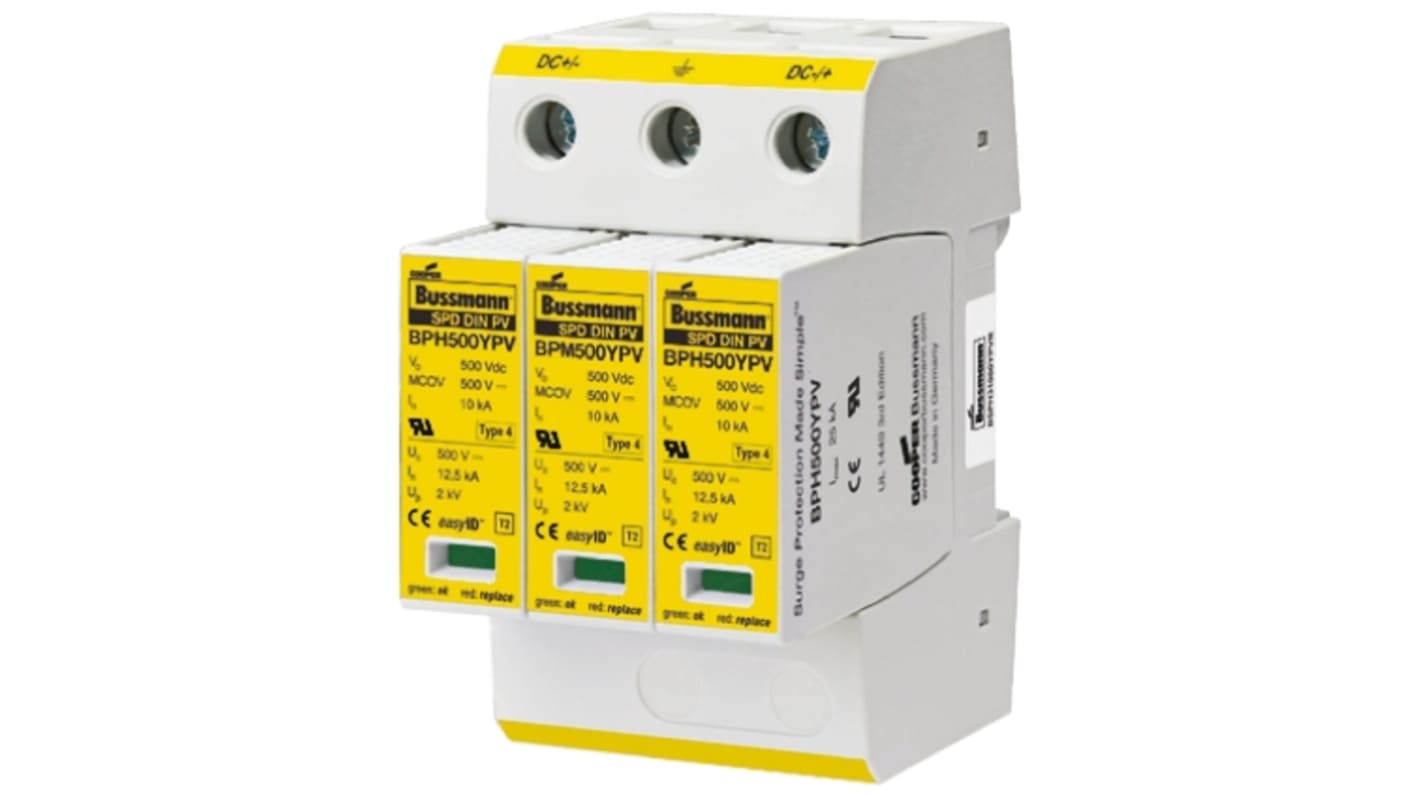Cooper Bussmann, BSPH Surge Suppressor Unit 1170 V dc Maximum Voltage Rating 40kA Maximum Surge Current Multi-Pole
- RS Stock No.:
- 756-4356
- Mfr. Part No.:
- BSPH31000YPV
- Brand:
- Eaton Bussmann Series

Image representative of range
Discontinued
- RS Stock No.:
- 756-4356
- Mfr. Part No.:
- BSPH31000YPV
- Brand:
- Eaton Bussmann Series
Specifications
Technical Reference
Legislation and Compliance
Product Details
Find similar products by selecting one or more attributes.
Select all | Attribute | Value |
|---|---|---|
| Brand | Eaton Bussmann Series | |
| Suppressor Type | Multi-Pole Protector | |
| Maximum Voltage Rating | 1170 V dc | |
| Mounting Type | DIN Rail | |
| Maximum Surge Current | 40kA | |
| Series | BSPH | |
| Length | 54mm | |
| Depth | 72mm | |
| Height | 90mm | |
| Dimensions | 54 x 72 x 90mm | |
| Minimum Operating Temperature | -40°C | |
| Maximum Operating Temperature | +80°C | |
| Select all | ||
|---|---|---|
Brand Eaton Bussmann Series | ||
Suppressor Type Multi-Pole Protector | ||
Maximum Voltage Rating 1170 V dc | ||
Mounting Type DIN Rail | ||
Maximum Surge Current 40kA | ||
Series BSPH | ||
Length 54mm | ||
Depth 72mm | ||
Height 90mm | ||
Dimensions 54 x 72 x 90mm | ||
Minimum Operating Temperature -40°C | ||
Maximum Operating Temperature +80°C | ||
- COO (Country of Origin):
- DE
Cooper Bussmann SPD Solutions - Photovoltaic
The Cooper Bussman Photovoltaic SPD solution consists of a base and locking module that features a combined disconnection and short-circuiting (shunting) device with safe electrical isolation to prevent fire damage due to DC arcs. An integrated DC fuse allows safe module replacement without arc formation. In case of insulation faults in the generator circuit, a reliable and tested fault-resistant Y circuit prevents damage to the surge protective devices. The green and red visual indicator flags show the module protective status (green = good, red = replace). Apart from this visual indication, the remote signalling option features a three terminal floating changeover contact that can be used as a make or break contact depending on the particular monitoring system design employed.
Modular DIN-Rail design with colour-coding and rejection feature makes it easy to identify, install and maintain
Built-in overcurrent protection eliminates the need for any additional fuse installation and wiring
easyID™ Visual indication and optional remote contact signaling make status monitoring simple
Fast-acting Short-Circuit Interrupting (SCI) technology responds efficiently to overvoltage conditions
Built-in overcurrent protection eliminates the need for any additional fuse installation and wiring
easyID™ Visual indication and optional remote contact signaling make status monitoring simple
Fast-acting Short-Circuit Interrupting (SCI) technology responds efficiently to overvoltage conditions
Surge Protection Devices, SPDs (DIN-rail)
Voltage surges, often referred to as spikes or transients are typically caused by switching of fluorescent lights, fuses blowing or nearby lightning activity. The worst voltage spikes are usually caused by lightning strikes and can reach up to 6000V, with current surges of over 3000A. The maximum size of the let-through voltage and current inrush depends on the location within the building's wiring system. BS7671: 2011 Amendment 1 Sections 443 and 534 cover risk assessment and provides guidance on protection of electronic equipment for installation engineers to follow. The fullest information on lightning and surge protection comes from the BSEN 62305 series of standards.
Related links
- Phoenix Contact, VALVETRAB MS Surge Arrester 1170 V dc Maximum Voltage Rating 40kA Maximum Surge Current Type 2 Arrester
- Roxburgh EMC 56 V dc Maximum Voltage Rating 40kA Maximum Surge Current Type 1
- Roxburgh EMC 56 V dc Maximum Voltage Rating 40kA Maximum Surge Current 1 Phase
- Phoenix Contact, VAL-SPP Surge Protection Plug 1000 V dc Maximum Voltage Rating 40kA Maximum Surge Current Surge
- Phoenix Contact, VAL-SPP Surge Protection Plug 1200 V dc Maximum Voltage Rating 40kA Maximum Surge Current Surge
- Phoenix Contact, VALVETRAB MS Surge Arrester 1500 V dc Maximum Voltage Rating 40kA Maximum Surge Current Type 2 Arrester
- Phoenix Contact, VAL-SPP Surge Protection Plug 800 V dc Maximum Voltage Rating 40kA Maximum Surge Current Surge
- Phoenix Contact, VAL-MB Surge Protection Device 800 V dc Maximum Voltage Rating 40kA Maximum Surge Current Surge
